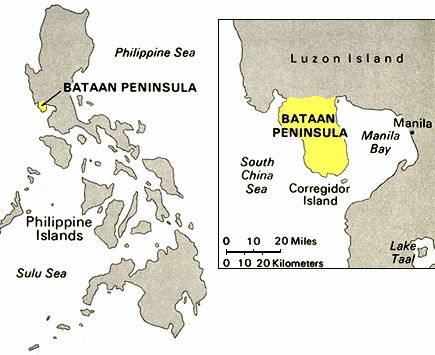

Bataan Peninsula juts into Manila Bay from the southwestern coast of Luzon, largest of the Philippine Islands. On Bataan Peninsula, United States and Filipino troops held out for just over three months against advancing Japanese forces during World War II. Late in December 1941, General Douglas MacArthur managed to withdraw his scattered troops into this hilly country. Once established on the peninsula, U.S. and Filipino forces found themselves hemmed in by the Japanese and cut off from any help.
For just over three months, this band of defenders beat back Japanese attacks. When Japanese forces broke through their lines, the Americans and Filipinos withdrew to the very tip of Bataan Peninsula. MacArthur was ordered to report to Australia, and Lieutenant General Jonathan M. Wainwright took command of United States and Filipino forces in the Philippines. Major General Edward P. King, Jr., took command of United States and Filipino forces on Bataan Peninsula. On April 9, 1942, General King surrendered to the Japanese. The Japanese took about 75,000 Americans and Filipinos prisoner. Some of the soldiers escaped to the fortress of Corregidor in Manila Bay. At Corregidor, the defenders held out against the Japanese until May 6, 1942.
In February 1945, troops under the command of MacArthur returned to Bataan. They landed on southern Bataan, captured points on Corregidor, and opened Manila Bay. Japanese forces surrendered, and surviving Americans and Filipinos were freed. In 1954, President Ramon R. Magsaysay of the Philippine Republic issued an order making the battlefield areas of Bataan and Corregidor national shrines.